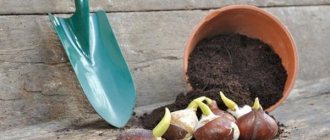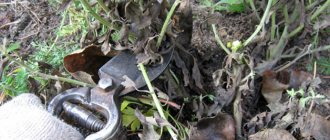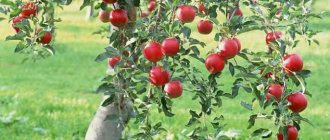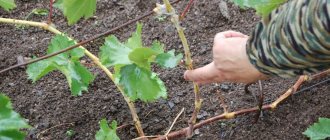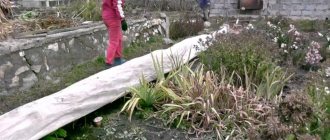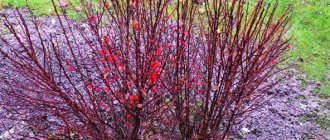Experienced gardeners like to carry out cleaning work on the site every year, striving for ideal order. When deep autumn arrives, annuals are removed and perennials are pruned, flower beds turn into areas of bare earth. Young people would consider such cleaning practically vandalism, because flower “garbage” is a special object to admire. Let's figure out where the truth is, which perennials need to be pruned in the autumn, and under what circumstances such actions will be meaningless.
Which shrubs cannot be pruned in the fall?
Shrubs and trees are trimmed before frost, but after sap flow stops. In the fall, sanitary, rejuvenating and thinning pruning is carried out, which is really necessary.
All crops that are “indicated” for these autumn procedures based on the type of flowering or fruiting need pruning and cleaning. And in this matter you should always focus on the individual indications of the species.
Shrubs and vines are not pruned for the winter if they bloom only on last year's shoots. Before constructing a protective shelter, they remove all leaves and remove plant debris under the bushes; if necessary, cut off young growth for normal ripening of shoots.
So, for example, clematis that bloom on the shoots of the current year are pruned heavily, varieties of the second group of pruning - densely double, Lanuginosa, Florida and Patens - are pruned for the winter by only half the length of the branches, but the remaining varieties are not pruned at all, removed from their supports and covering.
Shrubs and vines are not pruned for the winter if they bloom only on last year's shoots, for example, many varieties of clematis.
In everything that concerns perennial plants, everything is simple - it’s better to leave everything that you can. If there is no risk that the plants will die from rotting due to damping off and getting wet, pruning the dry parts can be safely postponed until spring, when simple cleaning will help quickly prepare the flower garden for the new season.
For plants that overwinter with leaves and remain beautiful even under snow, winter pruning is generally prohibited. Winter green plants - bergenia, heuchera, hellebore, periwinkle, ivy, lungwort, chickweed, primrose, gravilate, liverwort, santolina, heucherella, cinquefoil and many other species - are completely preserved for the winter, with the exception of affected leaves.
You should not prune overwintering carpets of armeria, saxifrage, tenacious, some types of speedwells, creeping sedums, periwinkles, arabis and aubriet for the winter - their appearance in the fall will itself tell you that you should not touch the plants. All bulbous leaves that grow wintering rosettes in the fall can also be included in this category.
The flower stalks of evergreen plants or those that overwinter with leaves can be cut off, but they can also add charm to the winter garden.
Crops in which the shoots and leaves dry out, turn yellow, but remain rigid; if desired, they are not cut off, but preserved. There is a simple rule - everything that dries out, but continues to hold its shape, can be left, but anything that is lying down, unattractively blackened, or soaking is better to remove.
Natural shelter from dry leaves and shoots will provide additional protection for the winter. In addition, dry curtains will help retain snow and decorate the winter garden.
You should not cut dry inflorescences on hard peduncles that perfectly retain their shape - covered with snow, dry fruit boxes and inflorescences will look charming, and many will also become additional food for birds.
A unique decoration of the winter garden - panicles of ornamental grasses, shields of sedum and yarrow, goldenrod, dry heads of alium, long “brushes” of chistema, dry heads of echinacea and rudbeckia...
A unique decoration of the winter garden are panicles of ornamental grasses and sedum shields.
The exception is plants, the abundant self-seeding of which is extremely undesirable. Lupins, solidagos, eryngiums, poskovniks, mordovniks, many asters look great with dry inflorescences, but can give chaotic self-seeding. Therefore, here you need to rely on your desire to see new plants in unexpected places.
If summer flowers, which disperse abundantly on their own, remain decorative as winter approaches, it is also worth weighing the risks of their spreading too rapidly throughout the garden. But it is also not necessary to remove annual plants with tough stems in the fall.
All originally southern plants adapted to a more severe climate - ornamental sages, rosemary, coreopsis, lavender, perovskia, which overwinter much better with natural protection - are not pruned for the winter.
Perennials such as maple leaf, some varieties of astilbe, brunnera, aconite and even Volzhanka change color in the fall no less brightly than bushes and trees, and it is worth removing their bright leaves only in the spring.
Ornamental grasses should not be cut for the winter - both evergreen species that reach the peak of their decorative value and turn into bright colors in the fall, as well as “ordinary” grasses whose foliage dies off for the winter. Dry clumps of grass will appear inconspicuous only until the first snowfall, completely transforming under the snow blanket.
Sedges, miscanthus, hakonechloa, pennisetums are left untouched, because it is much easier to clean the curtains in early spring, after the snow has melted. Large grains can be tied into sheaves, small grains can be left as is.
It overwinters well with dry, darkened bushes, especially if the inflorescences and aerial oregano have not been cut off. And the host’s favorite will successfully get rid of the leaves on its own; after the snow melts, not a trace usually remains.
The hosta will successfully get rid of the leaves on its own; after the snow melts, there is usually no trace left of them.
An exception should be made for herbaceous perennials, under which primroses and early spring bulbs are hidden - scillas, snowdrops, crocuses, etc. Cleaning in the fall will allow the meadows of the first flowers to look much neater in the spring, so you can sacrifice a few bushes of cereals and perennials.
What plants do not need to be pruned in winter?
Some shrubs have early spring flowering on the previous year's stems, so fall pruning does not always produce the expected results in spring. This can happen with lilac, forsythia, mock orange, large-leaved hydrangea, Japanese quince, spirea (white-flowering varieties only), and Thunberg barberry.
Autumn pruning of hydrangea
For these types of plants in the fall, only sanitary and anti-aging pruning is recommended, but not formative.
When rejuvenating pruning, cut out branches that are more than five years old, broken, dry, crooked or branches that greatly thicken the bush and can serve as a source of disease. The purpose of rejuvenating pruning is to increase flowering and the growth of young shoots.
Autumn pruning is also done for beautiful formation and successful wintering of the shrub. It is carried out after the end of sap flow, when the leaves fall on the bushes and the plants go into a dormant period.
Important! The procedure must be done before frost sets in, otherwise the sections will not have time to heal and infection may occur.
Other plants, such as evergreens and some perennials, should not be pruned in the fall to retain their foliage as frost protection. In addition, their stems and leaves, covered with frost or ice, will present an enchanting spectacle!
Herbs decorate the garden for a long time with their moving foliage and light inflorescences. At the first powder, the frost exalts them, but once this period has passed, it will be time to prune them to promote the emergence of vegetation and give the plant a more aesthetic appearance.
Plants that must be pruned in the fall
Mandatory pruning before winter is required for plants that are susceptible to rot and fungal diseases - with leaves and shoots that can become soggy either in the fall or in the spring and put the entire plant at risk.
So, herbaceous peonies, delphiniums, daylilies, aquilegias, tall bells, pyrethrum, bush phlox, speedwells are always cut. But plants with basket-shaped inflorescences - Helenium, asters, chrysanthemums - which are often included in this group, can either be cut at the height of short stumps or this procedure can be postponed until spring.
You should not leave the above-ground parts and foliage of any herbaceous plants that have been affected by diseases throughout the year in flower beds and any other decorative compositions for the winter. Destruction of leaves and dry stems, removal of debris under clumps and preventive treatment will help avoid re-infection and the spread of diseases in the garden.
For the winter, plants with leaves and shoots that can become wet and rot in the fall or spring, for example, daylily, are pruned.
It is worth collecting leaves and plant debris from the soil and replacing all the mulch if the plants suffered from infestation by aphids or other pests.
Why do you need to trim leaves from tomatoes?
Low-growing (determinant) tomato varieties do not need pruning. This procedure is necessary for tall tomatoes of indeterminate and hybrid varieties, which are grown for efficient use of soil.
Leaves affected by the disease should be cut off first.
When pruning tomatoes, you must remove:
- Old or diseased yellow leaves, which are often sources of late blight;
- Leaves on the north side, located deep in the bushes. They create a thick layer that prevents the bushes from being ventilated and the condensation and moisture falling on the foliage from evaporating, which stimulates the development of diseases;
- Leaves growing from clusters, weakening the plant. Such shoots must be removed if all the fruits in the cluster have successfully set;
- Lower leaves in contact with the soil. Removing these leaves exposes the stem and exposes it to sunlight and heat. For adult plants, the lower leaves are cut to the first fruiting cluster at a height of up to 30 cm;
- Leaves in the shade, as well as shading fruits. Such foliage disrupts photosynthesis processes and causes a decrease in yield.
Thickening of the tomato bush leads to slower ripening
Trimming leaves of a tomato video
Simple rules for autumn pruning
Whether to prune perennial plants or not is largely a matter of taste and the desire to preserve interesting details in the winter garden. If the garden is not visited in winter, leaving plants for decorative purposes makes no sense. And if there is simply not enough time in the fall for all the work, ornamental crops can be sacrificed in favor of more important work on preparing the garden for winter.
But those plants that require mandatory pruning (or the appearance of which you don’t like before winter) need to be pruned correctly.
It is better to prune from the third ten days of October to the beginning of the third ten days of November, focusing on the weather and choosing days immediately after the first frost or immediately before them.
Dry, fine days are suitable for pruning. And it is always better to wait for the above-ground part to dry out on its own, trying to cut on plants that have already entered a dormant period.
Hosts
Beginning flower growers often wonder whether they should cut hostas in the fall or not. Those who know this popular perennial know that in winter the dense foliage of the hosta will rot, and by spring there will be nothing left of them.
After the first slight frost, the bright leaf plate of these plants will change color and become another bright accent in the autumn flower bed. Know that cleaning the yellow leaves of these perennial plants will not cause any damage to “cleanliness and neatness.”
It is recommended that you take your time cutting down perennial plants that have beautiful fall colors, because their leaves will add color to a thinning flower bed and lift your spirits.
Do I need to prune perennials for the winter?
In an effort to achieve perfect order in the garden, older summer residents usually carry out an annual general cleaning of the site. With the onset of deep autumn, lush flower beds are thoroughly cleaned, turning into flat islands of bare earth after removing the annuals and pruning the perennials. But “advanced youth” will consider such cleaning almost an “act of vandalism”, finding in the flower “garbage” a special charm and an object of contemplation. But the truth, as always, hides somewhere in the middle. Let's try to figure out which perennial plants need to be pruned in the fall, and in which cases this procedure will be pointless or even harmful.
Do I need to prune perennials for the winter?
When is the best time to trim strawberry leaves?
Some gardeners begin to remove strawberry leaves when the berries are ripening, cutting the foliage so that the sun illuminates the berries. The disadvantage of this method is that birds can flock to the ripe berries and eat the crop.
Most people start pruning after the strawberries have borne fruit. The strawberries should have time to form a full rosette of leaves, so pruning is best done from the beginning of July to mid-August. At this time, spots often appear on the leaves; they may turn yellow, redden, and begin to dry or curl.
The leaves must be trimmed with pruning shears as close to the ground as possible, pruning should be done over a cloth or paper so that pests and fungal spores do not fall to the ground. Cut leaves cannot be put into compost; they must be burned. The earlier the pruning is done, the more time the strawberries will have to form new leaves and lay berries for next year.
In cold, rainy summers, as well as in regions with short summers, the leaf rosette may not have time to form, so it is better not to prune.
Perennials that don't need winter pruning
Absolutely no cutting
First of all, it is important to know which of the inhabitants of your garden will react sharply negatively to winter pruning. There are relatively few such perennials, and it is better, as they say, to immediately know them by sight in order to avoid the senseless stress of green pets. Such plants can be safely allowed to remain with leaves until spring.
It is strictly forbidden to prune winter-green perennials that overwinter with foliage for the winter.
The most common garden plants in this group include: lungwort, bergenia, woolly chlorine, cinquefoil, primroses, some types of garden geraniums, gravilat, hellebore, liverwort, mountain weed, santolina, heuchera, heucherella and some others. And also most of the so-called “rugs”: periwinkle, sedum (cresting species), subulate phlox, arabis, armeria, saxifrage, aubrieta, young, tenacious, certain types of speedwell, etc.
If you cut these crops for the winter, then in the spring the plants will need to spend a lot of effort to restore their green mass, so you most likely will not see flowering. And some perennials may not even survive the winter after such pruning.
It's better not to cut
It is advisable not to prune perennials for the winter, which are considered conditionally winter-hardy in our climate (frost hardiness zone 5-6). First of all, these include lavender, whorled coreopsis, perovskia, perennial lobelia and others. Such recommendations are mainly due to the fact that dried shoots contribute to better snow retention in winter, protecting the root system from the cold. For the same purpose, in the fall these flowers are covered with the tops of bushy annuals.
Also, for the winter, you cannot prune the shoots of princelings and clematis that bloom on last year’s shoots. Usually these are species varieties (clematis grape-leaved, Tangut, viticella, Manchurian, Alpine princeling, etc.), as well as varieties belonging to the second group of pruning, which are cut only to half before covering. As a rule, these are double or simple hybrids from the Lanuginosa, Patens and Florida groups.
Ornamental grasses: a separate issue
All representatives of cereals can be divided into two large classes: evergreens and herbs with foliage that dies off in the winter. However, in the fall, it is better to leave any cereals untouched. After all, dry foliage prevents excess moisture from reaching the roots, and most importantly, it protects the wintering buds from freezing.
This recommendation is especially relevant for heat-loving herbs, such as pennisetums and miscanthus. For greater reliability, these herbs are often recommended to be tied into a sheaf before wintering. But with the arrival of spring, dried clumps of grasses of the first group are cut off completely, while evergreen grasses are combed with a rake so that dry leaves do not interfere with the appearance of young foliage.
On a note!
in late autumn, flower stalks, as well as yellowed and damaged leaves, can be cut off from plants with overwintering leaves. But such hygiene procedures can be completely transferred to spring.
Ornamental grasses can become a real decoration for a site in the off-season.
Preparing the flower garden for winter
Looking at the autumn flower beds, I can’t even believe that winter is about to come.
Which plants should you prune for the winter and which should not?
“I’ve already put the garden in order, but there are still some worries in the flower garden.” Please tell me which flowers need to be pruned for the winter and which ones should not. I have Asiatic lilies, irises, heucheras, phlox, peonies, and monarda.
Elena Sergeeva. Minsk.
“Before winter, you should definitely trim peonies,” advises Zinaida Romanovich. — If you don’t cut them, then in the spring the soaked stems can no longer be trimmed with either pruning shears or a knife. And if you pull, you can pull out new shoots.
In addition, the lily also needs to be trimmed. Otherwise, water will flow through the stem tube to the bulb. Some people don’t prune astilbe, but I do it without fail. Because it needs to be sprinkled with a little earth on top so that the fresh buds that will grow upward do not freeze. Just don’t confuse powdering with hilling. To sprinkle means to rake the earth from all sides. Moreover, there is no need to remove it in the spring.
It is also necessary to trim irises, but not low, you should leave 10 centimeters. I usually measure all this with my own hand: I cut the irises into the palm of my hand. Some people screw in the stems of irises. This can be done in the summer, immediately after flowering. But in the fall, irises still need to be pruned. Phloxes, which after flowering we only cut off the tops of, now need to be cut as low as possible.
If desired, you can trim the monarda. Its stem is fragile and can be broken even in the spring. If you don’t cut it, the birds will find excellent food for themselves in the form of the seeds of this plant.
But hosta, heuchera and brunnera should not be pruned under any circumstances. The hosta will cover itself for the winter. Also, if a hosta is pruned, it will become very weak. Heuchera, surprisingly, already comes out with green leaves in early spring. It looks very funny. Therefore, considering that heuchera leaves are laid in winter, I do not recommend cutting it. But it wouldn’t hurt to insulate the plant, for example, by mulching under the leaves with mown grass or dry peat. Brunners should also be insulated in this way.
Marigolds will warm any flower in winter
— Please advise what can be used as a covering material for flowers. The fact is that many experts advise using spruce paws or leaves as a covering material. But we don’t have a forest nearby, and it’s somehow risky to use leaves from fruit trees. How else can you cover flowers for the winter?
Irina. Logoisk.
“I completely agree with you: it is sometimes difficult for us, summer residents, to find decent covering material for plants that winter on the site,” notes Zinaida Vasilievna. — I'll start with a little hint. Now you need to make an effort so that you have covering material for the next season. To do this, you need to stock up on marigold seeds. This is an exceptional covering material! In mid-October, marigolds are just beginning to bloom and it is important to collect as many seeds from them as possible. Pluck the flower heads and place them first on paper or a cloth. But next year be sure to plant marigolds in as many quantities as possible. You can plant them along the fence, along the perimeter of the site, or even outside the site, if possible.
The fact is that marigolds have bactericidal properties. The plant has abundant stems and many leaves. Have no doubt, with marigolds you will cover everything you can for the winter: from garlic to flowers that need to be covered for the winter - peony, irises, lily. If you cover the planting with flowers, a good air cushion will be formed. In addition, you can also sprinkle leaves on top - it turns out great.
By the way, marigolds come from Mexico. Therefore, if you leave the seeds in the ground, you won’t get flowers next year: they won’t tolerate sub-zero temperatures. You should definitely take the seeds to the city and store them at room temperature.
Another little tip: do not store the seeds in a plastic bag, it is better to wrap the seeds in a paper bag or place them in a fabric bag.
You can also use zinnia and calendula stems as covering material. These are the main three flowers, which are both a flower and a beautiful covering material available to us.
Therefore, if you have marigolds or calendula, and summer residents usually have plenty of them, then pull them right out by the roots and cover your plants.
How does a water lily winter?
— For the first time this year, I planted a nymphea (water lily) in the pond, but winter is coming, and I don’t know what to do with it. Tell me, how does this flower survive the winter?
Irina. Minsk.
“It all depends on what body of water your nymphea lives in,” said Valentina Alekseevna. - If it’s artificial, like mine, for example, then you’ll have to move this amazingly beautiful flower into the house. If it is not possible to leave flowers in the house for the winter, then you can place them in the basement or on the balcony. By the way, in the basement, where it is quite dark, the leaves of the nymph may become a little moldy. But this should not bother you, since damaged leaves are simply removed, and in the spring, when the nymph gets back into the reservoir, new ones easily grow.
First, prepare the containers in which the flowers will winter. Calculate so that the container in which the nymphea grows easily fits into the container for wintering. Then prepare water, preferably not tap water. I take from the well. Now all that remains is to get the nymphs out of the pond, put them in containers and fill them with water. And in April, when the sun is already hot, you can safely lower the nymphs back into the reservoir.
But if the reservoir is natural and deeper than a meter, then your nymph will not cause you any trouble and will calmly overwinter under the ice.
Ask questions on the website, send by mail: 220005 Minsk, PO Box 192, “My Dacha”, by email, call: (017) 290-94-92
Perennials that need winter pruning
The second broad group includes ornamental plants, which, on the contrary, require mandatory pruning for a safe winter sleep and successful flowering in the next season. It is better to add these green pets to the list of mandatory autumn gardening tasks in advance.
First of all, you need to prune plants that have shown signs of bacterial or fungal diseases during the season. At the same time, the tops of such perennials should under no circumstances be placed for composting. It is recommended to dry the affected shoots a little and burn them, or remove them from the site.
But even if the past season turned out to be favorable, and the plants were practically free from illness, it is still recommended to prune some perennials susceptible to fungal diseases, since pathogens could remain on their leaves and shoots. Such plants primarily include phlox, delphinium, speedwell, etc. By the way, it is also useful to treat the soil under them with fungicides in the fall.
If during the summer season there was an invasion of various pests in the flower garden (aphids, leaf beetles and others), or harmful insects have been attacking your flower bed for several years, then it is better to remove all fallen leaves under the plants and be sure to rake up the autumn leaves that fall into the flower garden, since This “warm blanket” helps pests survive the winter well.
Perennials and ornamental shrubs that overwinter with shelter must be thoroughly cleared of falling leaves before installing protective structures over them. First of all, this, of course, concerns roses, which more often than others suffer from fungal diseases. But for large-leaved hydrangea, such a measure will also not be superfluous.
On a note! Most varieties of large-leaved hydrangea bloom on last year's shoots, so when removing leaves it is important not to damage the apical buds of the shoots.
Some popular inhabitants of flower beds and flower beds produce very abundant self-seeding, so it is better to cut off their fruits before the seeds are fully ripe and scatter to all corners of the garden, giving unnecessary growth in the spring and adding more work to the gardener. Such prolific perennials include solidago, solidaster, novobelgian asters, lupine, rudbeckia, eryngium, mordovnik, pokonniki, etc.
Rules and timing for pruning leaves of tomatoes
Tomatoes are pruned in open ground twice a week, cutting off 2-3 leaves. Under ideal growing conditions, the crop grows at an accelerated pace. Therefore, the number of cut leaves can be increased to 5-6 pieces when pruning tomatoes in a greenhouse.
For southern latitudes, after the fruits have formed on all clusters, it is possible to completely trim the leaves of tomatoes. In this way, the plant is completely freed from unnecessary stress and the ripening of fruits is accelerated.
Thickened tomatoes before trimming
When pruning tomatoes, you should be guided by the general rule: above the brush, with unformed ovaries, almost all the leaves should be intact; and vice versa - if the ovaries are formed, then all the leaves can be removed under the brush.
The procedure begins after the formation of fruits on the first hand. The leaf is carefully broken off, pressing the base upward to the stem. It is wrong to pull the sheet down. This will damage the top layer of the stem from the base of the leaf.
Tomatoes in a greenhouse after trimming leaves
In open ground, experienced gardeners recommend removing leaves on a sunny morning so that the wound has time to dry before evening. It is not advisable to carry out the procedure on a rainy day or in the late afternoon.
Growing and pruning tomatoes in a greenhouse video
Pruning the leaves of a tomato in a greenhouse can be done at any time, without restrictions, but after it you should skip the next ventilation. The leaves are removed throughout the entire period of formation of the ovaries until the top is pinched (mid-end of September).
When pruning is a controversial issue
The next group of plants gives gardeners the opportunity to make their own decisions - whether to hurry with pruning in the fall, or put off the scissors until spring.
Annuals
Many gardeners really want to extend the summer, which, despite the autumn cold, seems to still be with us while the flowers are blooming in the flowerbeds. Fortunately, there is no need to rush when cutting annuals. Moreover, in some species, with the onset of cold weather, the color of the petals changes, for example, like in zinnia of the “Profusion” series.
It is best to cut annuals only after they have died naturally from frost. And don’t forget that flower tops come in very handy for covering heat-loving perennial plants. Marigolds, zinnias and calendula are especially good as winter blankets.
The seed heads of some flowers may benefit from pruning if they are aggressively propagating.
Primroses' neighbors
It is also recommended to remove the foliage and stems of perennial plants, under which bulbous primroses are planted, in the fall. Indeed, in this case, in early spring, the fragrant clumps of snowdrops will look clean and tidy, and their charm will not be overshadowed by the dull appearance of rotting foliage.
However, some lovers of a natural approach to design consider the combination of primroses and last year’s foliage to be quite organic. In addition, the rotting leaves serve as mulch for the bulbs and retain moisture in the soil in the event of a dry spring.
Hosts
The question of whether to cut hostas in the fall most often arises among beginning gardeners. But those who have been familiar with this popular perennial for many years have already noticed that during the winter the dense leaves of the hosta completely rot, and in the spring not a trace remains of them.
In addition, after the first small frosts, the variegated leaf blade of the hosta bizarrely changes color, becoming an additional color accent in the autumn flower garden. But, of course, if you take a “clean and tidy” approach, then removing the yellowed leaves of these perennials will not cause them any harm.
On a note!
do not rush to cut perennials with beautiful autumn colors (for example, maple leaf), because their foliage will add color to a thinning flower garden and lift your spirits.
Autumn pruning of astilbe, Volzhanka, aconite and bells is also at your discretion.
Annuals
Many gardeners dream of extending the summer period, which seems to remain with us while the plants in the flower beds are still blooming. You don’t have to rush to cut annual plants. After all, in some crops, when cold weather sets in, the color of the petals changes.
Cut annuals only when they have already died from frost. Do not forget that flower tops are useful for covering perennial crops that love warmth. Excellent winter shelter can be provided, for example, by calendula or marigolds.
The seed heads of some flowers may benefit from pruning if they are aggressively propagating. © Oksana Karpenko
When is the best time to start pruning plants for the winter?
Begin pruning perennial flowers from late October to mid-November. It is best to carry out this event in dry weather before the first frost or immediately after it. But remember that you should not rush to trim decorative perennials, since while the foliage has not yet faded, the above-ground part of the plants still continues to nourish their root system.
Before the arrival of frost, usually in October, most garden perennials are pruned: peonies, gaillardia, phlox, brunera, astilbe, Volzhanka, pyrethrum, aquilegia, delphinium, irises, tall bells and others. In this case, small smooth stumps 3–5 centimeters high should remain above the soil surface.
Among perennials there are many flowers, but there is no consensus on pruning them for the winter.
In November, with the onset of stable negative temperatures, young shoots of clematis (up to 20-25 centimeters), as well as daylilies (up to 10-12 centimeters), are pruned, since these plants can produce young shoots in the event of a prolonged warm autumn.
Step-by-step pruning of tomato leaves
The first pruning is at the stage of picking seedlings. To form a strong root system, a third of the plant is cut off along with the leaves. The growth of the bush and its root system occurs in breadth and covers a large area of food for the plant.
Trimming leaves of a tomato in a greenhouse
The second pruning of leaves of tomatoes is carried out in conjunction with pinching. Serves for better development of the crop, which helps to obtain a larger yield and prevent diseases.
Also, pruning of tomato leaves can be done at any time after the ovaries have formed, when signs of damage or disease are detected, or when they interfere with the ripening of the fruit.
Advantages of autumn pruning of ornamental plants
Some perennials (peonies, irises) have stems that disintegrate into elastic fibers over the winter or, on the contrary, become too coarse, making them difficult to trim in spring.
If you are under time pressure in the spring, then it is better to save time for planting and other garden work and carry out a general cleaning of the flower beds in the fall.
Many gardeners never come to their summer cottage in winter, so leaving plants uncut for the sake of their aesthetic appeal in the off-season makes no sense.
When pruning ornamental plants in spring, the likelihood of damage to young shoots increases, moreover, the tiny shoots of awakened perennials are easy to miss and simply trample underfoot while putting things in order in the flower garden.
Pruning roses in the fall - why should you do it?
Roses are heat-loving plants. They were originally grown in Greece and Ancient Rome. Now they can be found almost throughout Russia, including Siberia. But this requires proper care and preparation for the winter. This preparation also includes autumn pruning.
So why bother pruning before covering your roses?
By the way, there is no consensus on this matter. Some gardeners, especially in the southern regions, believe that if pruning is done, it is better to do it in the spring. I think this is not the best solution.
The fact is that autumn pruning of roses is desirable for several reasons.
Firstly, roses need to be covered for the winter, and this will be more difficult to do with unpruned roses.
Secondly, you need to remove unopened buds, young and damaged shoots, because they will still die and rot, which can harm the entire plant.
In addition, modern varieties of roses are sensitive to the return of autumn warmth, which encourages them to emerge from dormancy and return to a vegetative state. This is dangerous and pointless for roses during this period of time. The fact is that the juice, which has begun to flow again, freezes at sub-zero temperatures and destroys the stems. Pruning roses reduces the consequences of this process. In addition, autumn pruning of roses allows you to properly form a bush, which will begin to develop painlessly in the spring.
These circumstances indicate that you still need to prune roses for the winter. This increases the frost resistance of the plant, prevents the penetration of viruses and bacteria into damaged stems and promotes the proper formation of the bush.
Disadvantages of pruning perennials for the winter
In natural-style flower beds, last year's tough stems can become a natural support for plants prone to lodging.
Some heat-loving garden flowers emerge from the ground quite late. In these cases, last year's tops can serve as a kind of beacons so that you do not accidentally damage the plants when digging or confuse them with seedlings of perennial weeds.
The seed heads will greatly help winter birds to feed themselves during the winter, and thus you will attract them to your garden. For example, the light brown heads of monarda contain nutritious seeds-nuts that birds eat with pleasure.
But still, the main reason why more and more gardeners leave flower beds “untidy” in the winter is the special charm of the dried inflorescences of ornamental perennials. Brushes, peaks, balls, umbrellas, panicles and buttons - if you take a closer look at the seed heads of plants, you can really find a wide variety of original inflorescences with a clear structure that will become a worthy decoration of the garden in the off-season.
Sedum, echinacea, rudbeckia, liatris, chist, allium, goldenrod and many other perennials and ornamental grasses, when left in the winter, will give empty flower beds a graphic appearance, maintain shape, maintain structure and add volume.
And indeed, who among us has not been fascinated by the fabulous panicles of miscanthus, silvered by frost, the images of which abound in glossy garden magazines? However, we should not forget that our climate is in many ways different from Europe, and weather conditions do not always give us the opportunity to enjoy the fruits of the joint creativity of frost and faded plants.
But, nevertheless, even if an excessively snowy early winter carefully hides all the flower beds under a fluffy blanket, we will still be able to admire the floral graphics of Indian summer and late autumn. Therefore, I advise owners of elegant natural flower beds to safely put the scissors aside.
How to prune roses in the fall before covering
There is nothing particularly difficult in the procedure of pruning roses, but you still need to approach it responsibly and competently in order to do everything correctly and not harm the plants.
First of all, you need to prepare the necessary garden tools. If you approach this strictly, you will need everything necessary for pruning both young shoots and old, lignified branches. In this case, you will need scissors, a garden knife, pruning shears and a hedge trimmer.
In fact, you can only get by with pruning shears. But provided that they are good and spicy.
This is necessary so that the pruning shears do not crush the bark and destroy the wood at the cut site.
Before pruning, the tool must be treated with an alcohol-containing liquid or a solution of potassium permanganate.
And so, we move directly to the autumn pruning of roses.
It must be said right away that there are three types of pruning:
- long (light);
- average (moderate);
- short (strong or radical).
The type of pruning you choose depends on your intentions and the condition of the bush.
Long pruning is used when you only need to trim the bush and stimulate the formation of new shoots in the spring. In this case, only the tops of the bush 10-20 cm long are trimmed.
This pruning is used mainly in southern regions, where there is no need to worry too much about covering roses for the winter.
Short or heavy pruning is used when the bush is very old and needs to be rejuvenated. Or if the bush is severely damaged by fungal and other diseases. In this case, only a cutting with 2-3 buds is left. The remaining branches are cut off at the root.
In addition, short pruning is often used in the northern regions of Russia, since in this form it is easier to preserve them in winter.
Medium pruning is optimal in most cases, so we will talk about it in more detail. For a better understanding, I suggest you consider the process of medium pruning step by step.
We remove all debris and fallen leaves from under the bush, both from a sanitation point of view and so that nothing interferes with our work.
We carry out an external inspection of the bush in order to identify old, damaged, diseased and young, fragile branches. Then we remove them at the root, leaving a stump about 2 cm high. Do not spare the branches that seem to be healthy and already quite strong, but young and not lignified, since they still will not be able to survive the winter and will die.
Next, we remove at the root the branches that grow inside the bush or are weak or crooked. Such actions may seem a little ruthless to you, but if this is not done, the bush will be overly thickened, which will not benefit it in the future. It will be optimal if you leave only 3-5 of the strongest, healthiest branches on the bush. The rest are better removed.
Now we proceed directly to the middle pruning of roses. To do this, count 5-8 buds from the root and remove the rest of the branch using pruning shears.
When making a cut, you need to fulfill several important conditions:
- You need to choose a bud located not inside the bush, but outside. Otherwise, next year you will have to remove the shoot that has grown from it.
- The cut should be approximately 1cm. above the kidney at an angle of 45°. If you make a cut below 1 cm, you can harm the bud, and if it is higher, the remaining stump will still dry out and become a breeding ground for bacteria.
- The cut should not be located on the side of the bud, but on the opposite side, so that moisture with possible bacteria does not flow down the cut onto the bud.
- The completed cut should be white, which confirms that the branch we left is healthy.
Next, we perform the previous operation on all the branches of the bush that we left. The result should be a slightly fan-shaped bush with a height of approximately 30-50cm.
Now you need to remove the leaves from the cut branches. Whether to remove leaves or not is a controversial issue, but I believe it is better to remove them, since leaves left in the shelter can rot and be a source of fungal bacteria.
But you need to remove the leaves not by tearing them off with your hands, but by cutting them off with scissors or pruners, leaving a small piece of the stem from the leaf. If you tear it off with your hands, you can leave wounds on the branch.
Finally, we again remove all remnants of branches and leaves under the pruned bush and burn them so as not to accumulate a possible infection.
The end result should be a bush like this.
At this point, the average pruning of roses for the winter can be considered complete.
But if you need not just to prune roses for the winter, but to significantly rejuvenate the old bush, then this video will be useful to you.
As mentioned above, pruning and covering roses in different regions have significant differences. And the more severe the climate, the more attention should be paid to this issue.
A certified specialist talks in detail about how to do autumn pruning and covering roses for the winter in Siberia and Altai in this video.
